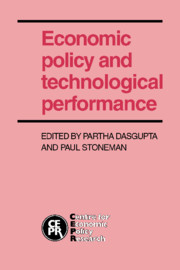Book contents
- Frontmatter
- Contents
- List of tables
- List of figures
- Preface
- List of participants
- Introduction
- 1 The economic theory of technology policy: an introduction
- 2 Current policy practice and problems from a UK perspective
- 3 The importance of technology policy
- 4 The value of patents as indicators of inventive activity
- 5 Learning to learn, localized learning and technological progress
- 6 Some analytical observations on diffusion policies
- 7 International trade and technology policy
- 8 Some new standards for the economics of standardization in the information age
- Index
6 - Some analytical observations on diffusion policies
Published online by Cambridge University Press: 17 September 2009
- Frontmatter
- Contents
- List of tables
- List of figures
- Preface
- List of participants
- Introduction
- 1 The economic theory of technology policy: an introduction
- 2 Current policy practice and problems from a UK perspective
- 3 The importance of technology policy
- 4 The value of patents as indicators of inventive activity
- 5 Learning to learn, localized learning and technological progress
- 6 Some analytical observations on diffusion policies
- 7 International trade and technology policy
- 8 Some new standards for the economics of standardization in the information age
- Index
Summary
Introduction
My intention in this paper is to explore government intervention in the process of diffusion. My definition of diffusion is the process by which a technology already innovated spreads across an economy. Two ‘stylized facts’ on diffusion can usefully be presented at this stage, (i) diffusion takes time, often many years and (ii) the pattern of market penetration of a new technology often follows some S-shaped path when plotted against time. Much of the diffusion literature is concerned with ‘explaining’ these two stylized facts, or testing explanatory models to see to what extent they are capable of explaining observed diffusion patterns. I have surveyed such literature elsewhere, see Stoneman (1983a, 1983b, 1986). My reading of this literature is that we do not have one dominant theory or explanation of diffusion that will apply in all situations; we have instead a selection of hypotheses stressing different aspects of economic behaviour that may be more or less important in specific situations. For the majority of this paper I will concentrate on three separate frameworks that emphasise different aspects of behaviour; the first concentrates on ‘strategic’ behaviour, the second emphasises information and uncertainty and the third stresses differences between potential adopters. Any real world situation is likely to contain elements of all three, but we may learn a considerable amount by considering the frameworks separately.
- Type
- Chapter
- Information
- Economic Policy and Technological Performance , pp. 154 - 168Publisher: Cambridge University PressPrint publication year: 1987
- 2
- Cited by



